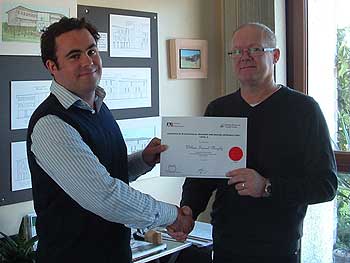Aoraki’s Eco-Building Course Has Given Hastings Designer The Edge
Why build a wall to act as a windbreak when you can use natural contours of the land to achieve the same effect?
Why erect concrete barriers to sunlight when shade can be achieved by planting deciduous trees which maximise shade in the summer and let light through in the darker winter months?
Why use a non-renewable resource like concrete anyway, when more natural and eco-friendly materials are available?
Expect to hear questions like these if you engage Hawkes Bay’s newest landscape architect Willie Murphy to design your new property or add value to your rural address.
Mr Murphy, who holds a Bachelor of Landscape Architecture degree from Lincoln University, has added an ecological focus to his qualification by completing Aoraki Polytechnic’s Certificate in Ecological Building and Design course, studying online. He iscrediting his successful entry into the increasingly in-demand eco-landscape business to that.
In fact, he says, his introduction through Aoraki Polytechnic to the concepts of building sustainably and using materials and design principles related to the environment in a way that doesn’t harm the environment has given his new business the edge in the province over others in his field.
Mr Murphy has just launched Createscape throughout the Hawkes Bay, but based in the seaside settlement of Te Awanga, just east of Hastings.
Studying online from February to May this year, Mr Murphy undertook the Aoraki course to add to his existing degree an “ecological overlay” to meet the increasing awareness in New Zealand for landscape design that was in harmony with the environment.
Aoraki runs the course in partnership with the Building Biology and Ecology Institute of New Zealand (BBE). The distance-learning course was developed jointly to pioneer a more sustainable, eco-architecture in New Zealand.
Mr Murphy said the Aoraki Polytechnic certificate had given him a “clear lead in the marketplace”.
“First up, I now have a greatly increased knowledge of building materials, how to build things, what materials to use, things to do with sites and the planning and location of buildings and houses to best meet, counter and complement prevailing winds and ecology in a given area.
“It’s given me an overall appreciation of designing with nature instead of against her,” he said.
“When designing a new home you study the overall impact of the building on the site, where the prevailing winds come from, where the sun rises and sets, and which areas need more or less shade to achieve energy and ecological efficiency.”
From a farming background and growing up in Tolaga Bay, Gisborne, Mr Murphy just wants his clients to appreciate what the countryside has to offer.
“I’m interested in ways for us to create a better environment for us to live in. I hate to see it being spoiled through bad design and the use of non-renewable resources.”
He said cement was an example and he tried to discourage the use of concrete where a suitable alternative was available.
“Because of its weight, the process of extracting and transporting cement is expensive from an energy and environmental point of view.”
Mr Murphy sees the Aoraki Polytechnic course as his springboard to business success.
Lately undertaking wetland restoration work, restoring water quality and creating habitats for plants and animals, he says he will be looking to pursue a landscape architecture career in this area.
“Aoraki staff Ann Fitzgerald and Jenny Rattenbury have designed and delivered this course around the concept of working with building architects and I will be expanding on that,” Mr Murphy said.
“The focus for all architects is sustainability and I now have the edge now in this area.
“The fast pace of the building industry today means that cheaper material options are often used. Cheaper does not always mean the best.”
“Some of the things we use in New Zealand are materials that have been made in another country using processes that are not immediately apparent to us and from non-renewable resources, and they might break down quicker over time,” he said.
“But that’s beginning to change. By using local materials and local labour you can create a regional identity and a better environment.
“Building architects like to work with landscape architects who use that philosophy well.Aoraki Polytechnic has given me that edge.”
Hastings landscape architect Willie Murphy accepts Aoraki Polytechnic’s Certificate in Ecological Building and Design from Steven Jaycock representing the Building Biology and Ecology Institute of New Zealand (BBE), partners to Aoraki in the distance-learning course developed to pioneer a more sustainable, eco-architecture in New Zealand.
Willie Murphy at Createascape www.createscape.co.nz
Aoraki Polytechnic http://www.aoraki.ac.nz/


